Exploring Secure Attachment and Its Significance in Child Development
VerifiedAdded on 2022/10/11
|8
|2297
|6
Essay
AI Summary
This essay examines the concept of secure attachment and its significance in child development, drawing upon the work of Mary Ainsworth, John Bowlby, and others. It explores the four main attachment styles—secure, insecure avoidant, insecure ambivalent, and disorganized—and the methodologies used to assess them, such as the Strange Situation Classification. The essay argues for the critical role of secure attachment in fostering healthy relationships, self-identity, and confidence, while also acknowledging the complexities and limitations of attachment theory. It discusses adult attachment theories and the long-term effects of early experiences, concluding that, despite some unresolved issues, secure attachment is crucial for an individual's future success and well-being. The essay highlights the importance of sensitive parenting and the expectation of positive future relationships for those with secure attachment experiences, while recognizing the need for further research to address the nuances of attachment patterns.
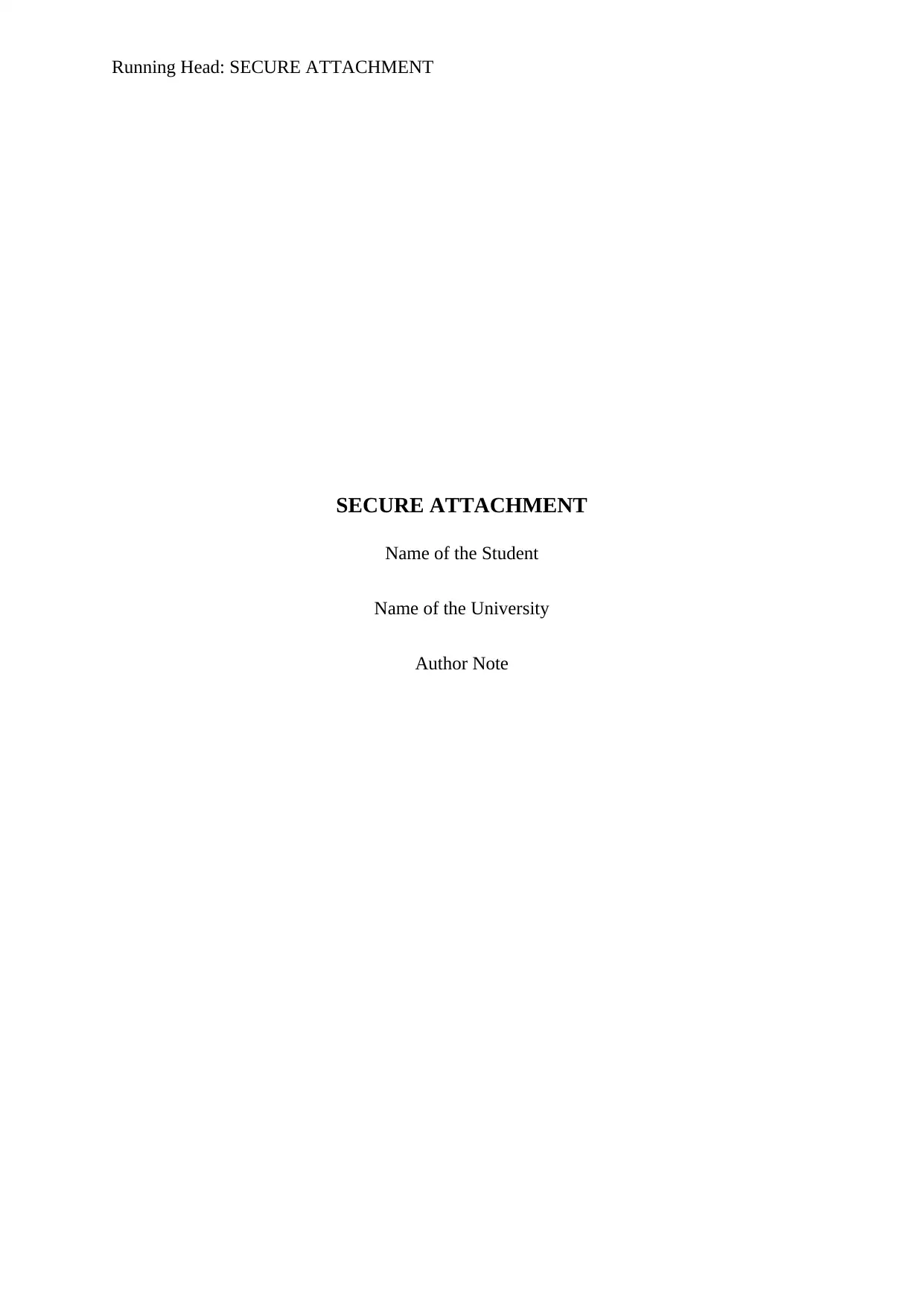
Running Head: SECURE ATTACHMENT
SECURE ATTACHMENT
Name of the Student
Name of the University
Author Note
SECURE ATTACHMENT
Name of the Student
Name of the University
Author Note
Paraphrase This Document
Need a fresh take? Get an instant paraphrase of this document with our AI Paraphraser
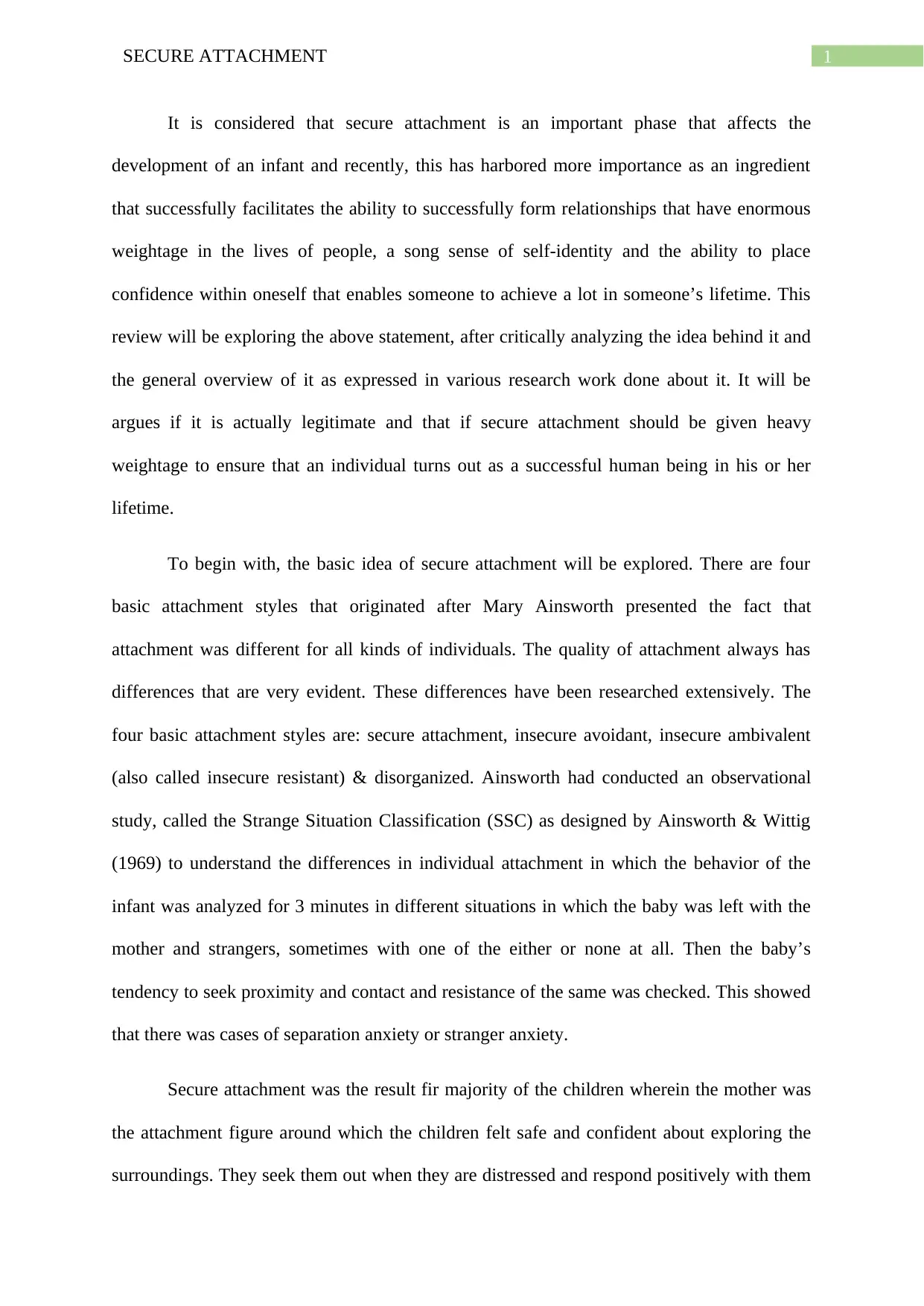
1SECURE ATTACHMENT
It is considered that secure attachment is an important phase that affects the
development of an infant and recently, this has harbored more importance as an ingredient
that successfully facilitates the ability to successfully form relationships that have enormous
weightage in the lives of people, a song sense of self-identity and the ability to place
confidence within oneself that enables someone to achieve a lot in someone’s lifetime. This
review will be exploring the above statement, after critically analyzing the idea behind it and
the general overview of it as expressed in various research work done about it. It will be
argues if it is actually legitimate and that if secure attachment should be given heavy
weightage to ensure that an individual turns out as a successful human being in his or her
lifetime.
To begin with, the basic idea of secure attachment will be explored. There are four
basic attachment styles that originated after Mary Ainsworth presented the fact that
attachment was different for all kinds of individuals. The quality of attachment always has
differences that are very evident. These differences have been researched extensively. The
four basic attachment styles are: secure attachment, insecure avoidant, insecure ambivalent
(also called insecure resistant) & disorganized. Ainsworth had conducted an observational
study, called the Strange Situation Classification (SSC) as designed by Ainsworth & Wittig
(1969) to understand the differences in individual attachment in which the behavior of the
infant was analyzed for 3 minutes in different situations in which the baby was left with the
mother and strangers, sometimes with one of the either or none at all. Then the baby’s
tendency to seek proximity and contact and resistance of the same was checked. This showed
that there was cases of separation anxiety or stranger anxiety.
Secure attachment was the result fir majority of the children wherein the mother was
the attachment figure around which the children felt safe and confident about exploring the
surroundings. They seek them out when they are distressed and respond positively with them
It is considered that secure attachment is an important phase that affects the
development of an infant and recently, this has harbored more importance as an ingredient
that successfully facilitates the ability to successfully form relationships that have enormous
weightage in the lives of people, a song sense of self-identity and the ability to place
confidence within oneself that enables someone to achieve a lot in someone’s lifetime. This
review will be exploring the above statement, after critically analyzing the idea behind it and
the general overview of it as expressed in various research work done about it. It will be
argues if it is actually legitimate and that if secure attachment should be given heavy
weightage to ensure that an individual turns out as a successful human being in his or her
lifetime.
To begin with, the basic idea of secure attachment will be explored. There are four
basic attachment styles that originated after Mary Ainsworth presented the fact that
attachment was different for all kinds of individuals. The quality of attachment always has
differences that are very evident. These differences have been researched extensively. The
four basic attachment styles are: secure attachment, insecure avoidant, insecure ambivalent
(also called insecure resistant) & disorganized. Ainsworth had conducted an observational
study, called the Strange Situation Classification (SSC) as designed by Ainsworth & Wittig
(1969) to understand the differences in individual attachment in which the behavior of the
infant was analyzed for 3 minutes in different situations in which the baby was left with the
mother and strangers, sometimes with one of the either or none at all. Then the baby’s
tendency to seek proximity and contact and resistance of the same was checked. This showed
that there was cases of separation anxiety or stranger anxiety.
Secure attachment was the result fir majority of the children wherein the mother was
the attachment figure around which the children felt safe and confident about exploring the
surroundings. They seek them out when they are distressed and respond positively with them
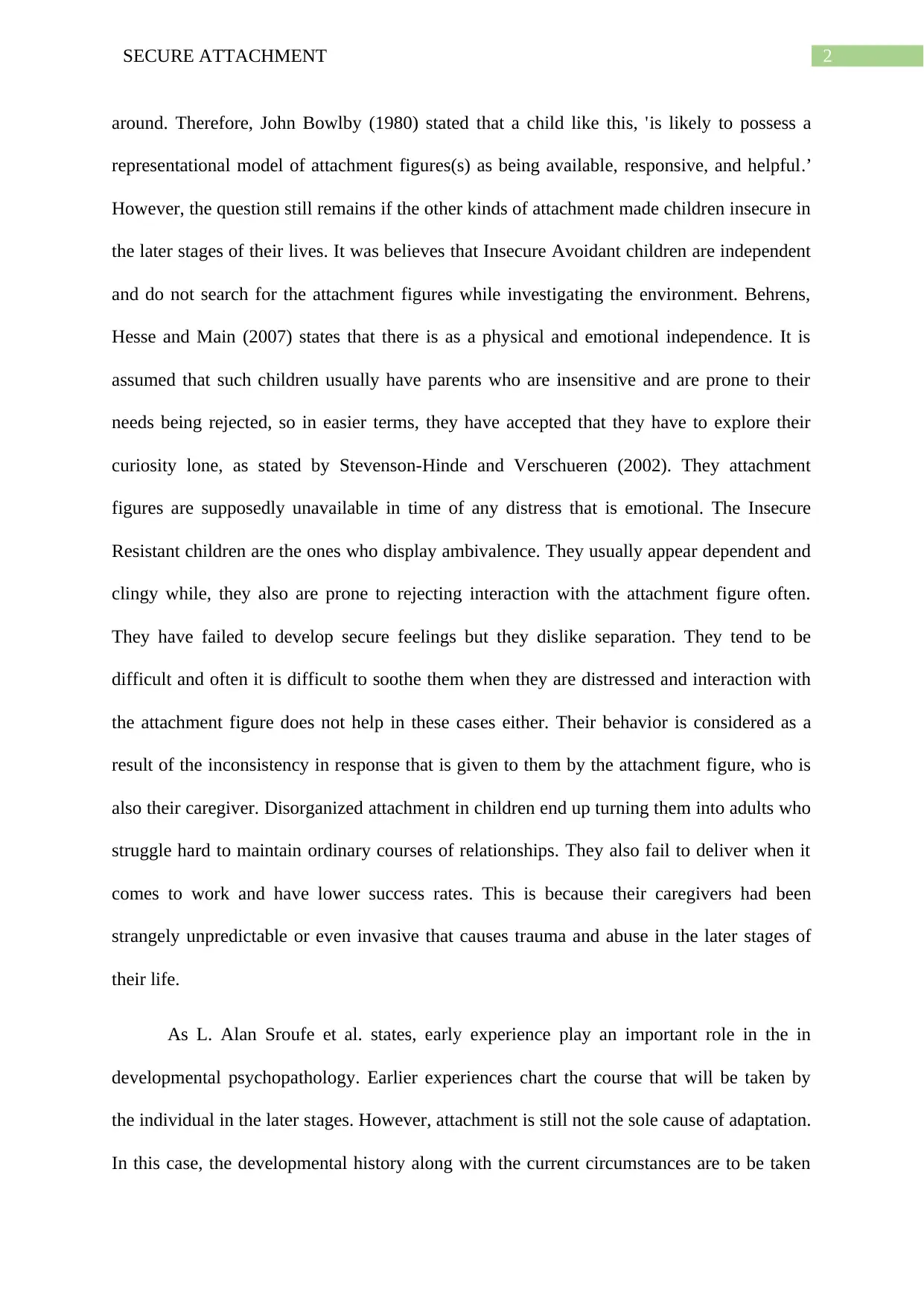
2SECURE ATTACHMENT
around. Therefore, John Bowlby (1980) stated that a child like this, 'is likely to possess a
representational model of attachment figures(s) as being available, responsive, and helpful.’
However, the question still remains if the other kinds of attachment made children insecure in
the later stages of their lives. It was believes that Insecure Avoidant children are independent
and do not search for the attachment figures while investigating the environment. Behrens,
Hesse and Main (2007) states that there is as a physical and emotional independence. It is
assumed that such children usually have parents who are insensitive and are prone to their
needs being rejected, so in easier terms, they have accepted that they have to explore their
curiosity lone, as stated by Stevenson-Hinde and Verschueren (2002). They attachment
figures are supposedly unavailable in time of any distress that is emotional. The Insecure
Resistant children are the ones who display ambivalence. They usually appear dependent and
clingy while, they also are prone to rejecting interaction with the attachment figure often.
They have failed to develop secure feelings but they dislike separation. They tend to be
difficult and often it is difficult to soothe them when they are distressed and interaction with
the attachment figure does not help in these cases either. Their behavior is considered as a
result of the inconsistency in response that is given to them by the attachment figure, who is
also their caregiver. Disorganized attachment in children end up turning them into adults who
struggle hard to maintain ordinary courses of relationships. They also fail to deliver when it
comes to work and have lower success rates. This is because their caregivers had been
strangely unpredictable or even invasive that causes trauma and abuse in the later stages of
their life.
As L. Alan Sroufe et al. states, early experience play an important role in the in
developmental psychopathology. Earlier experiences chart the course that will be taken by
the individual in the later stages. However, attachment is still not the sole cause of adaptation.
In this case, the developmental history along with the current circumstances are to be taken
around. Therefore, John Bowlby (1980) stated that a child like this, 'is likely to possess a
representational model of attachment figures(s) as being available, responsive, and helpful.’
However, the question still remains if the other kinds of attachment made children insecure in
the later stages of their lives. It was believes that Insecure Avoidant children are independent
and do not search for the attachment figures while investigating the environment. Behrens,
Hesse and Main (2007) states that there is as a physical and emotional independence. It is
assumed that such children usually have parents who are insensitive and are prone to their
needs being rejected, so in easier terms, they have accepted that they have to explore their
curiosity lone, as stated by Stevenson-Hinde and Verschueren (2002). They attachment
figures are supposedly unavailable in time of any distress that is emotional. The Insecure
Resistant children are the ones who display ambivalence. They usually appear dependent and
clingy while, they also are prone to rejecting interaction with the attachment figure often.
They have failed to develop secure feelings but they dislike separation. They tend to be
difficult and often it is difficult to soothe them when they are distressed and interaction with
the attachment figure does not help in these cases either. Their behavior is considered as a
result of the inconsistency in response that is given to them by the attachment figure, who is
also their caregiver. Disorganized attachment in children end up turning them into adults who
struggle hard to maintain ordinary courses of relationships. They also fail to deliver when it
comes to work and have lower success rates. This is because their caregivers had been
strangely unpredictable or even invasive that causes trauma and abuse in the later stages of
their life.
As L. Alan Sroufe et al. states, early experience play an important role in the in
developmental psychopathology. Earlier experiences chart the course that will be taken by
the individual in the later stages. However, attachment is still not the sole cause of adaptation.
In this case, the developmental history along with the current circumstances are to be taken
⊘ This is a preview!⊘
Do you want full access?
Subscribe today to unlock all pages.

Trusted by 1+ million students worldwide
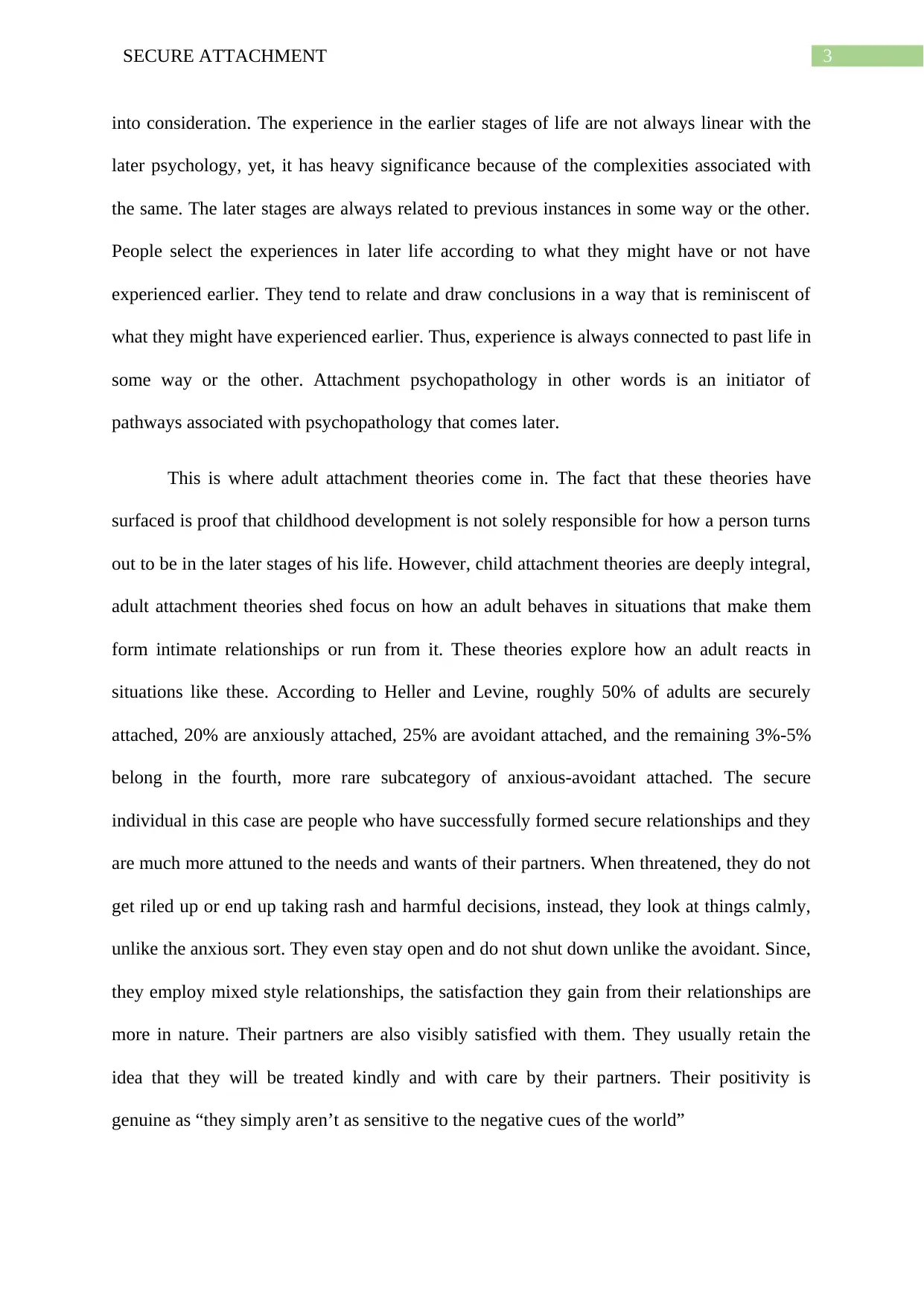
3SECURE ATTACHMENT
into consideration. The experience in the earlier stages of life are not always linear with the
later psychology, yet, it has heavy significance because of the complexities associated with
the same. The later stages are always related to previous instances in some way or the other.
People select the experiences in later life according to what they might have or not have
experienced earlier. They tend to relate and draw conclusions in a way that is reminiscent of
what they might have experienced earlier. Thus, experience is always connected to past life in
some way or the other. Attachment psychopathology in other words is an initiator of
pathways associated with psychopathology that comes later.
This is where adult attachment theories come in. The fact that these theories have
surfaced is proof that childhood development is not solely responsible for how a person turns
out to be in the later stages of his life. However, child attachment theories are deeply integral,
adult attachment theories shed focus on how an adult behaves in situations that make them
form intimate relationships or run from it. These theories explore how an adult reacts in
situations like these. According to Heller and Levine, roughly 50% of adults are securely
attached, 20% are anxiously attached, 25% are avoidant attached, and the remaining 3%-5%
belong in the fourth, more rare subcategory of anxious-avoidant attached. The secure
individual in this case are people who have successfully formed secure relationships and they
are much more attuned to the needs and wants of their partners. When threatened, they do not
get riled up or end up taking rash and harmful decisions, instead, they look at things calmly,
unlike the anxious sort. They even stay open and do not shut down unlike the avoidant. Since,
they employ mixed style relationships, the satisfaction they gain from their relationships are
more in nature. Their partners are also visibly satisfied with them. They usually retain the
idea that they will be treated kindly and with care by their partners. Their positivity is
genuine as “they simply aren’t as sensitive to the negative cues of the world”
into consideration. The experience in the earlier stages of life are not always linear with the
later psychology, yet, it has heavy significance because of the complexities associated with
the same. The later stages are always related to previous instances in some way or the other.
People select the experiences in later life according to what they might have or not have
experienced earlier. They tend to relate and draw conclusions in a way that is reminiscent of
what they might have experienced earlier. Thus, experience is always connected to past life in
some way or the other. Attachment psychopathology in other words is an initiator of
pathways associated with psychopathology that comes later.
This is where adult attachment theories come in. The fact that these theories have
surfaced is proof that childhood development is not solely responsible for how a person turns
out to be in the later stages of his life. However, child attachment theories are deeply integral,
adult attachment theories shed focus on how an adult behaves in situations that make them
form intimate relationships or run from it. These theories explore how an adult reacts in
situations like these. According to Heller and Levine, roughly 50% of adults are securely
attached, 20% are anxiously attached, 25% are avoidant attached, and the remaining 3%-5%
belong in the fourth, more rare subcategory of anxious-avoidant attached. The secure
individual in this case are people who have successfully formed secure relationships and they
are much more attuned to the needs and wants of their partners. When threatened, they do not
get riled up or end up taking rash and harmful decisions, instead, they look at things calmly,
unlike the anxious sort. They even stay open and do not shut down unlike the avoidant. Since,
they employ mixed style relationships, the satisfaction they gain from their relationships are
more in nature. Their partners are also visibly satisfied with them. They usually retain the
idea that they will be treated kindly and with care by their partners. Their positivity is
genuine as “they simply aren’t as sensitive to the negative cues of the world”
Paraphrase This Document
Need a fresh take? Get an instant paraphrase of this document with our AI Paraphraser
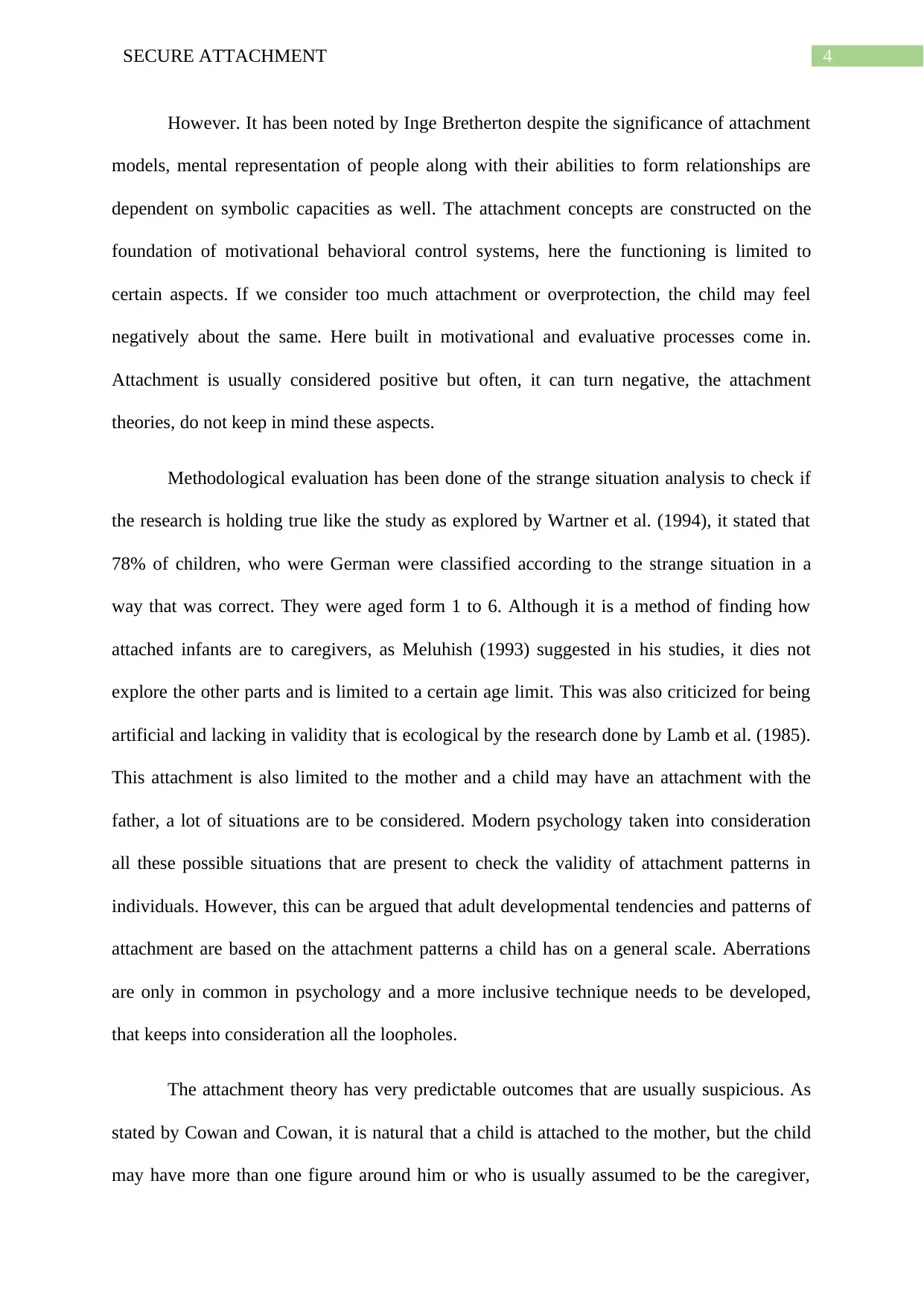
4SECURE ATTACHMENT
However. It has been noted by Inge Bretherton despite the significance of attachment
models, mental representation of people along with their abilities to form relationships are
dependent on symbolic capacities as well. The attachment concepts are constructed on the
foundation of motivational behavioral control systems, here the functioning is limited to
certain aspects. If we consider too much attachment or overprotection, the child may feel
negatively about the same. Here built in motivational and evaluative processes come in.
Attachment is usually considered positive but often, it can turn negative, the attachment
theories, do not keep in mind these aspects.
Methodological evaluation has been done of the strange situation analysis to check if
the research is holding true like the study as explored by Wartner et al. (1994), it stated that
78% of children, who were German were classified according to the strange situation in a
way that was correct. They were aged form 1 to 6. Although it is a method of finding how
attached infants are to caregivers, as Meluhish (1993) suggested in his studies, it dies not
explore the other parts and is limited to a certain age limit. This was also criticized for being
artificial and lacking in validity that is ecological by the research done by Lamb et al. (1985).
This attachment is also limited to the mother and a child may have an attachment with the
father, a lot of situations are to be considered. Modern psychology taken into consideration
all these possible situations that are present to check the validity of attachment patterns in
individuals. However, this can be argued that adult developmental tendencies and patterns of
attachment are based on the attachment patterns a child has on a general scale. Aberrations
are only in common in psychology and a more inclusive technique needs to be developed,
that keeps into consideration all the loopholes.
The attachment theory has very predictable outcomes that are usually suspicious. As
stated by Cowan and Cowan, it is natural that a child is attached to the mother, but the child
may have more than one figure around him or who is usually assumed to be the caregiver,
However. It has been noted by Inge Bretherton despite the significance of attachment
models, mental representation of people along with their abilities to form relationships are
dependent on symbolic capacities as well. The attachment concepts are constructed on the
foundation of motivational behavioral control systems, here the functioning is limited to
certain aspects. If we consider too much attachment or overprotection, the child may feel
negatively about the same. Here built in motivational and evaluative processes come in.
Attachment is usually considered positive but often, it can turn negative, the attachment
theories, do not keep in mind these aspects.
Methodological evaluation has been done of the strange situation analysis to check if
the research is holding true like the study as explored by Wartner et al. (1994), it stated that
78% of children, who were German were classified according to the strange situation in a
way that was correct. They were aged form 1 to 6. Although it is a method of finding how
attached infants are to caregivers, as Meluhish (1993) suggested in his studies, it dies not
explore the other parts and is limited to a certain age limit. This was also criticized for being
artificial and lacking in validity that is ecological by the research done by Lamb et al. (1985).
This attachment is also limited to the mother and a child may have an attachment with the
father, a lot of situations are to be considered. Modern psychology taken into consideration
all these possible situations that are present to check the validity of attachment patterns in
individuals. However, this can be argued that adult developmental tendencies and patterns of
attachment are based on the attachment patterns a child has on a general scale. Aberrations
are only in common in psychology and a more inclusive technique needs to be developed,
that keeps into consideration all the loopholes.
The attachment theory has very predictable outcomes that are usually suspicious. As
stated by Cowan and Cowan, it is natural that a child is attached to the mother, but the child
may have more than one figure around him or who is usually assumed to be the caregiver,
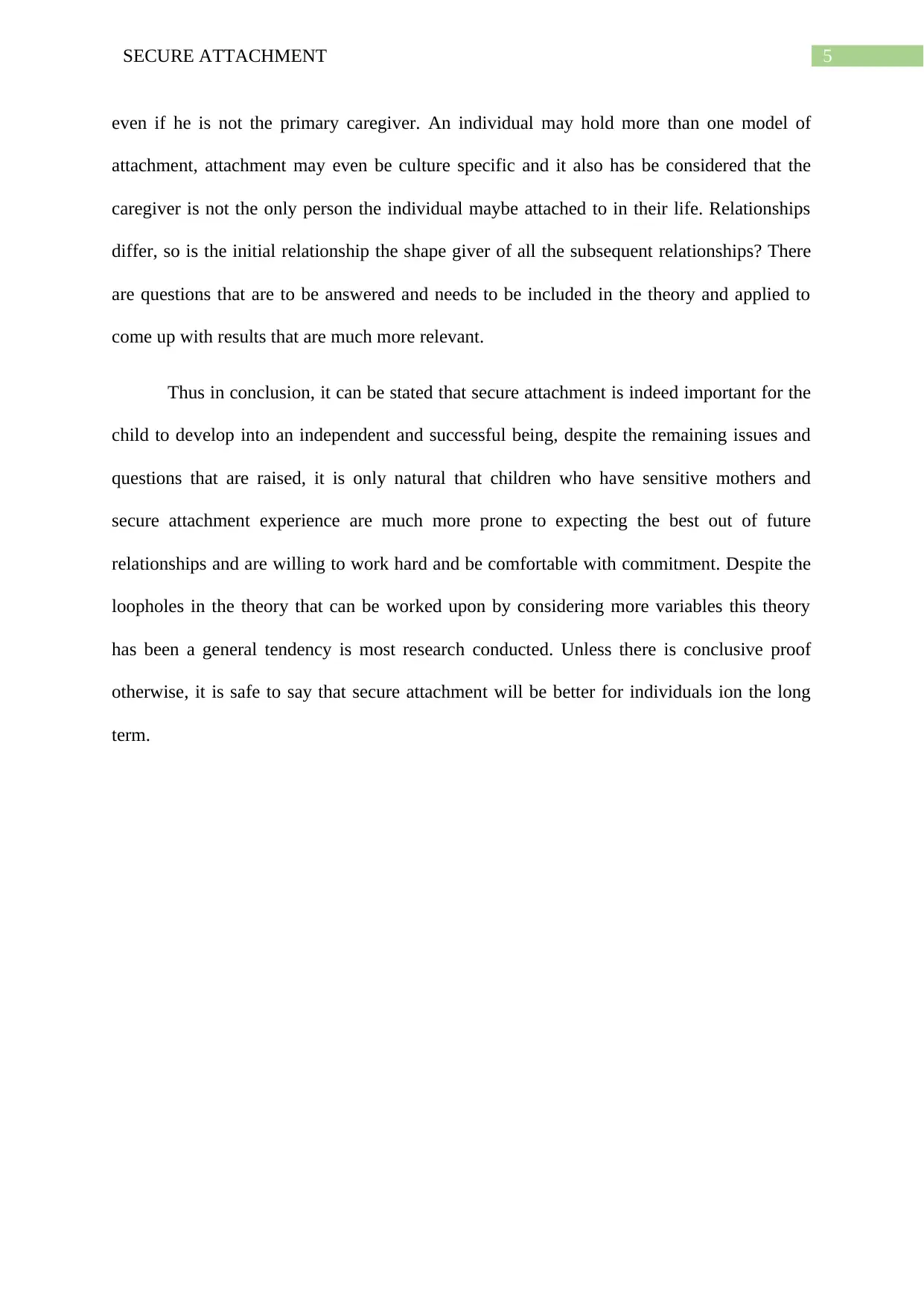
5SECURE ATTACHMENT
even if he is not the primary caregiver. An individual may hold more than one model of
attachment, attachment may even be culture specific and it also has be considered that the
caregiver is not the only person the individual maybe attached to in their life. Relationships
differ, so is the initial relationship the shape giver of all the subsequent relationships? There
are questions that are to be answered and needs to be included in the theory and applied to
come up with results that are much more relevant.
Thus in conclusion, it can be stated that secure attachment is indeed important for the
child to develop into an independent and successful being, despite the remaining issues and
questions that are raised, it is only natural that children who have sensitive mothers and
secure attachment experience are much more prone to expecting the best out of future
relationships and are willing to work hard and be comfortable with commitment. Despite the
loopholes in the theory that can be worked upon by considering more variables this theory
has been a general tendency is most research conducted. Unless there is conclusive proof
otherwise, it is safe to say that secure attachment will be better for individuals ion the long
term.
even if he is not the primary caregiver. An individual may hold more than one model of
attachment, attachment may even be culture specific and it also has be considered that the
caregiver is not the only person the individual maybe attached to in their life. Relationships
differ, so is the initial relationship the shape giver of all the subsequent relationships? There
are questions that are to be answered and needs to be included in the theory and applied to
come up with results that are much more relevant.
Thus in conclusion, it can be stated that secure attachment is indeed important for the
child to develop into an independent and successful being, despite the remaining issues and
questions that are raised, it is only natural that children who have sensitive mothers and
secure attachment experience are much more prone to expecting the best out of future
relationships and are willing to work hard and be comfortable with commitment. Despite the
loopholes in the theory that can be worked upon by considering more variables this theory
has been a general tendency is most research conducted. Unless there is conclusive proof
otherwise, it is safe to say that secure attachment will be better for individuals ion the long
term.
⊘ This is a preview!⊘
Do you want full access?
Subscribe today to unlock all pages.

Trusted by 1+ million students worldwide
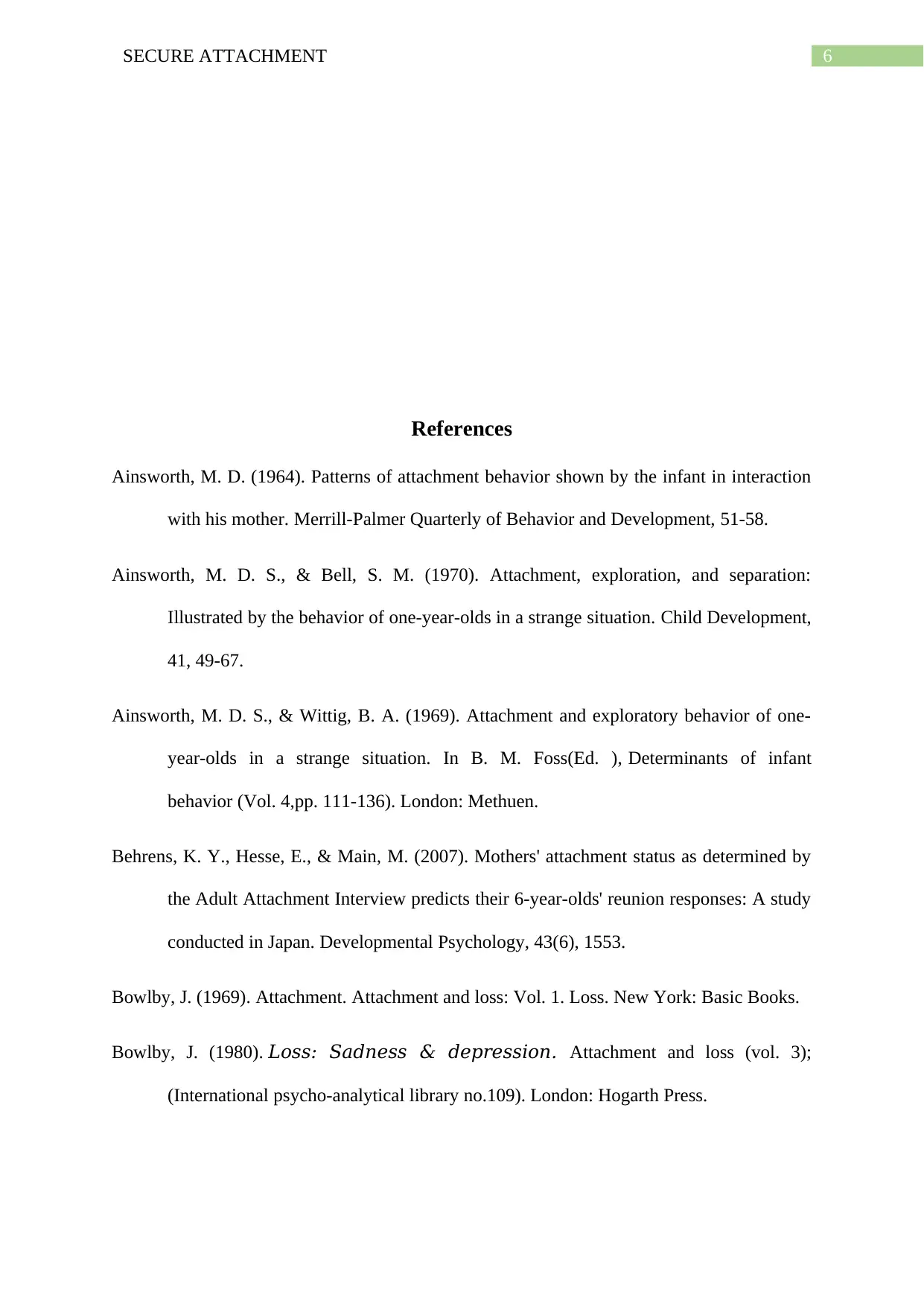
6SECURE ATTACHMENT
References
Ainsworth, M. D. (1964). Patterns of attachment behavior shown by the infant in interaction
with his mother. Merrill-Palmer Quarterly of Behavior and Development, 51-58.
Ainsworth, M. D. S., & Bell, S. M. (1970). Attachment, exploration, and separation:
Illustrated by the behavior of one-year-olds in a strange situation. Child Development,
41, 49-67.
Ainsworth, M. D. S., & Wittig, B. A. (1969). Attachment and exploratory behavior of one-
year-olds in a strange situation. In B. M. Foss(Ed. ), Determinants of infant
behavior (Vol. 4,pp. 111-136). London: Methuen.
Behrens, K. Y., Hesse, E., & Main, M. (2007). Mothers' attachment status as determined by
the Adult Attachment Interview predicts their 6-year-olds' reunion responses: A study
conducted in Japan. Developmental Psychology, 43(6), 1553.
Bowlby, J. (1969). Attachment. Attachment and loss: Vol. 1. Loss. New York: Basic Books.
Bowlby, J. (1980). Loss: Sadness & depression. Attachment and loss (vol. 3);
(International psycho-analytical library no.109). London: Hogarth Press.
References
Ainsworth, M. D. (1964). Patterns of attachment behavior shown by the infant in interaction
with his mother. Merrill-Palmer Quarterly of Behavior and Development, 51-58.
Ainsworth, M. D. S., & Bell, S. M. (1970). Attachment, exploration, and separation:
Illustrated by the behavior of one-year-olds in a strange situation. Child Development,
41, 49-67.
Ainsworth, M. D. S., & Wittig, B. A. (1969). Attachment and exploratory behavior of one-
year-olds in a strange situation. In B. M. Foss(Ed. ), Determinants of infant
behavior (Vol. 4,pp. 111-136). London: Methuen.
Behrens, K. Y., Hesse, E., & Main, M. (2007). Mothers' attachment status as determined by
the Adult Attachment Interview predicts their 6-year-olds' reunion responses: A study
conducted in Japan. Developmental Psychology, 43(6), 1553.
Bowlby, J. (1969). Attachment. Attachment and loss: Vol. 1. Loss. New York: Basic Books.
Bowlby, J. (1980). Loss: Sadness & depression. Attachment and loss (vol. 3);
(International psycho-analytical library no.109). London: Hogarth Press.
Paraphrase This Document
Need a fresh take? Get an instant paraphrase of this document with our AI Paraphraser
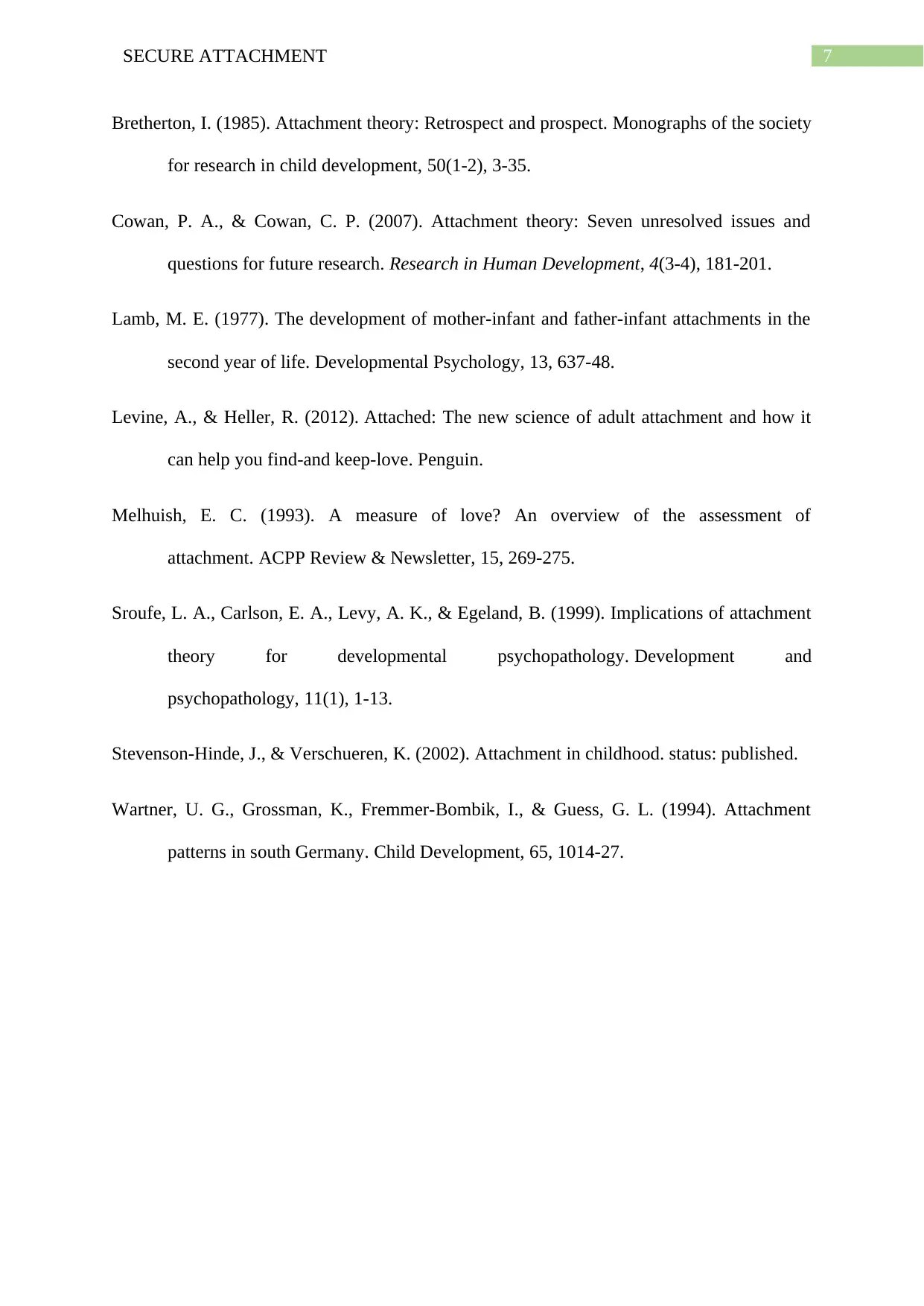
7SECURE ATTACHMENT
Bretherton, I. (1985). Attachment theory: Retrospect and prospect. Monographs of the society
for research in child development, 50(1-2), 3-35.
Cowan, P. A., & Cowan, C. P. (2007). Attachment theory: Seven unresolved issues and
questions for future research. Research in Human Development, 4(3-4), 181-201.
Lamb, M. E. (1977). The development of mother-infant and father-infant attachments in the
second year of life. Developmental Psychology, 13, 637-48.
Levine, A., & Heller, R. (2012). Attached: The new science of adult attachment and how it
can help you find-and keep-love. Penguin.
Melhuish, E. C. (1993). A measure of love? An overview of the assessment of
attachment. ACPP Review & Newsletter, 15, 269-275.
Sroufe, L. A., Carlson, E. A., Levy, A. K., & Egeland, B. (1999). Implications of attachment
theory for developmental psychopathology. Development and
psychopathology, 11(1), 1-13.
Stevenson-Hinde, J., & Verschueren, K. (2002). Attachment in childhood. status: published.
Wartner, U. G., Grossman, K., Fremmer-Bombik, I., & Guess, G. L. (1994). Attachment
patterns in south Germany. Child Development, 65, 1014-27.
Bretherton, I. (1985). Attachment theory: Retrospect and prospect. Monographs of the society
for research in child development, 50(1-2), 3-35.
Cowan, P. A., & Cowan, C. P. (2007). Attachment theory: Seven unresolved issues and
questions for future research. Research in Human Development, 4(3-4), 181-201.
Lamb, M. E. (1977). The development of mother-infant and father-infant attachments in the
second year of life. Developmental Psychology, 13, 637-48.
Levine, A., & Heller, R. (2012). Attached: The new science of adult attachment and how it
can help you find-and keep-love. Penguin.
Melhuish, E. C. (1993). A measure of love? An overview of the assessment of
attachment. ACPP Review & Newsletter, 15, 269-275.
Sroufe, L. A., Carlson, E. A., Levy, A. K., & Egeland, B. (1999). Implications of attachment
theory for developmental psychopathology. Development and
psychopathology, 11(1), 1-13.
Stevenson-Hinde, J., & Verschueren, K. (2002). Attachment in childhood. status: published.
Wartner, U. G., Grossman, K., Fremmer-Bombik, I., & Guess, G. L. (1994). Attachment
patterns in south Germany. Child Development, 65, 1014-27.
1 out of 8
Related Documents
Your All-in-One AI-Powered Toolkit for Academic Success.
+13062052269
info@desklib.com
Available 24*7 on WhatsApp / Email
![[object Object]](/_next/static/media/star-bottom.7253800d.svg)
Unlock your academic potential
Copyright © 2020–2025 A2Z Services. All Rights Reserved. Developed and managed by ZUCOL.





